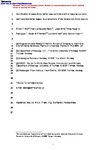Identification of paleo Arctic winter sea ice limits and the marginal ice zone: Optimised biomarker-based reconstructions of late Quaternary Arctic sea ice
| dc.contributor.author | Belt, ST | |
| dc.contributor.author | Cabedo-Sanz, P | |
| dc.contributor.author | Smik, L | |
| dc.contributor.author | Navarro-Rodriguez, A | |
| dc.contributor.author | Berben, SMP | |
| dc.contributor.author | Knies, J | |
| dc.contributor.author | Husum, K | |
| dc.date.accessioned | 2016-02-16T15:04:29Z | |
| dc.date.available | 2016-02-16T15:04:29Z | |
| dc.date.issued | 2015-12-01 | |
| dc.identifier.issn | 0012-821X | |
| dc.identifier.issn | 1385-013X | |
| dc.identifier.uri | http://hdl.handle.net/10026.1/4335 | |
| dc.description.abstract |
Analysis of >100 surface sediments from across the Barents Sea has shown that the relative abundances of the mono-unsaturated sea ice diatom-derived biomarker IP25 and a tri-unsaturated highly branched isoprenoid (HBI) lipid (HBI III) are characteristic of the overlying surface oceanographic conditions, most notably, the location of the seasonal sea ice edge. Thus, while IP25 is generally limited to locations experiencing seasonal sea ice, with higher abundances found for locations with longer periods of ice cover, HBI III is found in sediments from all sampling locations, but is significantly enhanced in sediments within the vicinity of the retreating sea ice edge or marginal ice zone (MIZ). The response of HBI III to this well-defined sea ice scenario also appears to be more selective than that of the more generic phytoplankton biomarker, brassicasterol. The potential for the combined analysis of IP25 and HBI III to provide more detailed assessments of past sea ice conditions than IP25 alone has been investigated by quantifying both biomarkers in three marine downcore records from locations with contrasting modern sea ice settings. For sediment cores from the western Barents Sea (intermittent seasonal sea ice) and the northern Norwegian Sea (ice-free), high IP25 and low HBI III during the Younger Dryas (ca. 12.9-11.9 cal.kyr BP) is consistent with extensive sea cover, with relatively short periods of ice-free conditions resulting from late summer retreat. Towards the end of the YD (ca. 11.9-11.5 cal.kyr BP), a general amelioration of conditions resulted in a near winter maximum ice edge scenario for both locations, although this was somewhat variable, and the eventual transition to predominantly ice-free conditions was later for the western Barents Sea site (ca. 9.9 cal.kyr BP) compared to NW Norway (ca. 11.5 cal.kyr BP). For both locations, coeval elevated HBI III (but absent IP25) potentially provides further evidence for increased Atlantic Water inflow during the early Holocene, but this interpretation requires further investigation. In contrast, IP25 and HBI III data obtained from a core from the northern Barents Sea demonstrate that seasonal sea ice prevailed throughout the Holocene, but with a gradual shift from winter ice edge conditions during the early Holocene to more sustained ice cover in the Neoglacial; a directional shift that has undergone a reverse in the last ca. 150 yr according to observational records. Our combined surface and downcore datasets suggest that combined analysis of IP25 and HBI III can provide information on temporal variations in the position of the maximum (winter) Arctic sea ice extent, together with insights into sea ice seasonality by characterisation of the MIZ. Combining IP25 with HBI III in the form of the previously proposed PIP25 index yields similar outcomes to those obtained using brassicasterol as the phytoplankton marker. Importantly, however, some problems associated with use of a variable balance factor employed in the PIP25 calculation, are potentially alleviated using HBI III. | |
| dc.format.extent | 127-139 | |
| dc.language | en | |
| dc.language.iso | en | |
| dc.publisher | Elsevier BV | |
| dc.subject | sea ice | |
| dc.subject | Arctic | |
| dc.subject | proxy | |
| dc.subject | IP25 | |
| dc.subject | biomarker | |
| dc.subject | paleoclimate | |
| dc.title | Identification of paleo Arctic winter sea ice limits and the marginal ice zone: Optimised biomarker-based reconstructions of late Quaternary Arctic sea ice | |
| dc.type | journal-article | |
| dc.type | Article | |
| plymouth.author-url | http://gateway.webofknowledge.com/gateway/Gateway.cgi?GWVersion=2&SrcApp=PARTNER_APP&SrcAuth=LinksAMR&KeyUT=WOS:000363828600013&DestLinkType=FullRecord&DestApp=ALL_WOS&UsrCustomerID=11bb513d99f797142bcfeffcc58ea008 | |
| plymouth.volume | 431 | |
| plymouth.publication-status | Published | |
| plymouth.journal | EARTH AND PLANETARY SCIENCE LETTERS | |
| dc.identifier.doi | 10.1016/j.epsl.2015.09.020 | |
| plymouth.organisational-group | /Plymouth | |
| plymouth.organisational-group | /Plymouth/Faculty of Science and Engineering | |
| plymouth.organisational-group | /Plymouth/Faculty of Science and Engineering/School of Geography, Earth and Environmental Sciences | |
| plymouth.organisational-group | /Plymouth/REF 2021 Researchers by UoA | |
| plymouth.organisational-group | /Plymouth/REF 2021 Researchers by UoA/UoA07 Earth Systems and Environmental Sciences | |
| plymouth.organisational-group | /Plymouth/Research Groups | |
| plymouth.organisational-group | /Plymouth/Research Groups/Marine Institute | |
| plymouth.organisational-group | /Plymouth/Users by role | |
| plymouth.organisational-group | /Plymouth/Users by role/Academics | |
| plymouth.organisational-group | /Plymouth/Users by role/Researchers in ResearchFish submission | |
| dcterms.dateAccepted | 2015-09-14 | |
| dc.rights.embargodate | 2016-12-1 | |
| dc.identifier.eissn | 1385-013X | |
| dc.rights.embargoperiod | Not known | |
| rioxxterms.versionofrecord | 10.1016/j.epsl.2015.09.020 | |
| rioxxterms.licenseref.uri | http://www.rioxx.net/licenses/all-rights-reserved | |
| rioxxterms.licenseref.startdate | 2015-12-01 | |
| rioxxterms.type | Journal Article/Review |


